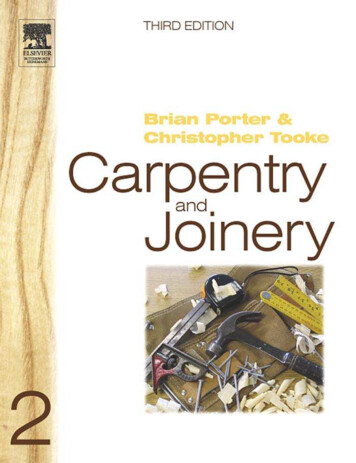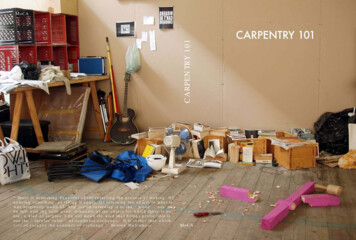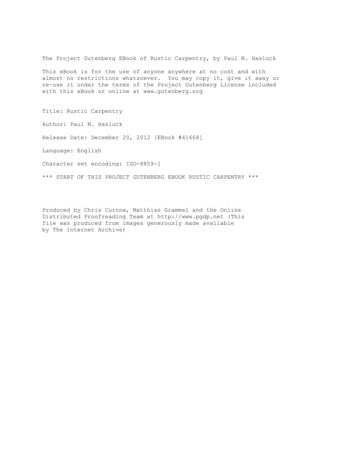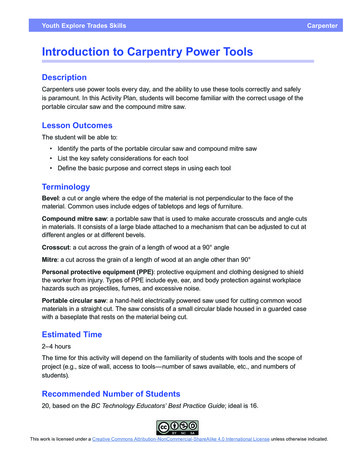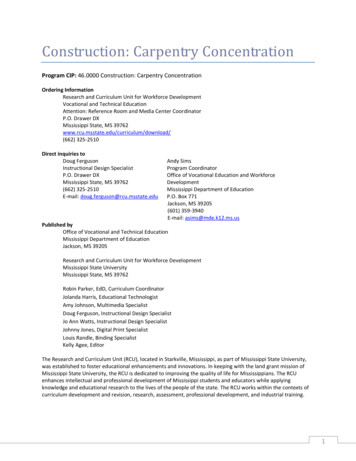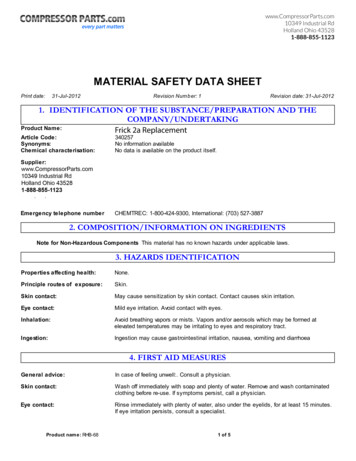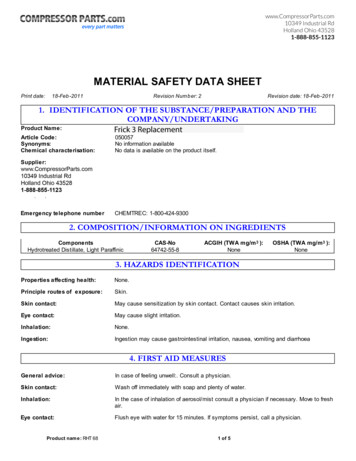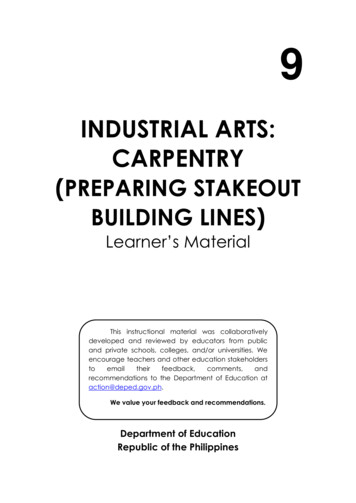
Transcription
9INDUSTRIAL ARTS:CARPENTRY(PREPARING STAKEOUTBUILDING LINES)Learner’s MaterialThis instructional material was collaborativelydeveloped and reviewed by educators from publicand private schools, colleges, and/or universities. Weencourage teachers and other education mendations to the Department of Education ataction@deped.gov.ph.We value your feedback and recommendations.Department of EducationRepublic of the Philippines
Technology & Livelihood Education – Grade 9Industrial Arts: Carpentry - (Preparing Stakeout Building Lines)Learner’s MaterialFirst Edition, 2014Republic Act 8293, section 176 states that: No copyright shall subsist in any workof the Government of the Philippines. However, prior approval of the government agency oroffice wherein the work is created shall be necessary for exploitation of such work for profit.Such agency or office may, among other things, impose as a condition the payment ofroyalties.Borrowed materials (i.e., songs, stories, poems, pictures, photos, brand names,trademarks, etc.) included in this book are owned by their respective copyright holders.Every effort has been exerted to locate and seek permission to use these materials fromtheir respective copyright owners. The publisher and authors do not represent nor claimownership over them.Published by the Department of EducationSecretary: Br. Armin A. Luistro FSCUndersecretary: Dina S. Ocampo, Ph.D.Development Team of the Learner’s MaterialConsultant: Rosendo R. Rafael, Howard Mark N. Pleteand Clodualdo V. PaitonAuthors:ROBERTO S. DAQUIL andFERNANDO N. MAGALANGEditor: Lando T. GuzmanReviewers: Dr. Orlando E. Manuel, Dr. Fely L. Manuel,Dr. Romeo R. Vicmudo, Merham N. Abelardo, Arnel C. Anonical,Joel G. Castillo, Marvin A. Mendoza, Lino A. OlitIllustrator:Subject Specialists: Albert Erni, James Julius M. Liquigan,Owen S. MilambilingManagement Team: Lolita M. Andrada, Jocelyn DR Andaya,Bella O. Mariñas and Jose D. Tuguinayo Jr.Department of Education-Instructional Materials Council Secretariat(DepEd-IMCS)Office Address:5th Floor Mabini Building, DepEd ComplexMeralco Avenue, Pasig CityPhilippines 1600Telefax:(02) 634-1054 or 634-1072E-mail Address:imcsetd@yahoo.com
Table of ContentsPREPARING STAKEOUT BUILDING LINESIntroduction .1Pre/Diagnostic 1.1Information Sheet 1.1 .3Self-Check 1.1 .4Information Sheet 1.2 .4Self-Check 1.2 .7Information Sheet 1.3 .8Self-Check 1.3 .9Pre/Diagnostic 2.9Information Sheet 2.1.10Self-Check 2.1.10Activity Sheet 2.1 .11Summative Assessment .141
Content StandardPerformance StandardThe learner demonstratesunderstanding in staking outbuilding lines.The learner independently preparesmaterials and stake out building linesin carpentry based on constructionstandards.PREPARING STAKEOUT BUILDING LINESI. INTRODUCTIONWelcome to the Learners Module in “Carpentry NC II TLE Grade 9” Thismodule contains training materials and activities for you to complete.The unit of competency “Prepare Stake-out Building Lines”contains theknowledge, skills and attitudes required for a Carpentry NC II TLE Grade 9course.You are required to go through a series of learning activities in order tocomplete each of the learning outcomes of this module. In each learningoutcome there are Information Sheets and Activity Sheets. Follow theseactivities on your own and answer the Self-Check at the end of each learningactivity.PREPARE TOOLS, EQUIPMENT AND MATERIALS FOR STAKEOUTBULDING LINES Identify tools and materials for stakeout building linesPrepare tools,materials and necessary permit for stakeout buildinglines.Select appropriate Personal Protective Equipment (PPE)PRE/DIAGNOSTIC ASSESSMENTDirections: Match column A with column B. Write your answers on your notebook.A1.2.3.4.5.6.BFalling objectsObjects that could puncture the skinObjects that could roll over the worker’s feetRadiationToxic chemicalsExcessive noise2A. Safety shoesB. Hard hatC. GogglesD. RespiratorsE. GlovesF. Ear muff
7.8.9.10.A requirement in constructing a buildingIt is used to check the verticalnessIt is used to check squarenessIt is used to drive and pull out nailsG. Plumb bobH. Steel squareI. Claw hammerJ. Building permitINFORMATION SHEET 1.1TYPES AND USES OF PERSONAL PROTECTIVE EQUIPMENT (PPE)The use of protective clothing and equipment is not the only solution forpreventing accident.It is most important to understand that the primary protection againstaccidents is to identify possible hazards and take the necessary safety measures toeliminate the hazard.When necessary, workers should be provided with protective clothing andother personal protective equipment.Types of Personal Protective Equipment (PPE)1. Eye and face protection Goggles and face protection must be worn toprotect workers from flying particles, liquid chemicals, acids, chemical gasesor vapors. Workers must also be protected from radiation during welding,touching, soldering, brazing and other operations that emit light.2. Head protection Hard hats must be worn where there is danger of fallingobjects. Specialized hard hats are required to reduce electrical shockhazards.3. Foot protection Safety shoes with impact protection are required in workareas where heavy objects or tool could be accidentally dropped on the feet.3
Safety shoes with puncture protection are required when working aroundnails, wires, tacks, scrap metal and other objects that could pierce the feet.4. Hand protection Gloves are required to protect workers from cuts, scrapes,punctures, burns, chemical absorption or extreme temperature5. Hearing protection Appropriate ear muffs or ear plugs should be worn tolessen the noise in the workplace.6. Respirators: Appropriate respirators must be worn as a last resort if it is notpossible to ventilate the work area properly.SELF-CHECK 1.1TYPES AND USES OF PERSONAL PROTECTIVE EQUIPMENT (PPE)Directions: Match column A with column B. Write your answers on yournotebooksAB1. Falling objectsa. Safety shoes2. Objects that could roll over the worker’s feetb. Hard hats3. Heatc. Goggles4. Radiationd. Respirator5. Toxic chemicalse. Gloves6. Excessive noisef. Ear muffINFORMATION SHEET 1.2TOOLS AND MATERIALS USED FOR STAKING-OUT BUILDING LINESIt is very important to know the names and proper use of each of the varioustools we need in our works. In addition, application on their proper care andmaintenance will give the following advantages: efficiency of the work, qualityspeed, accomplishment, and accuracy.Tools and Materials1.Claw hammer is used fordriving and pulling out nails.4
2. Water hose level is used to determinethe horizontal levelness of batter boards,and parts of the building such as beam,floorings and others.3. Bar Level or Spirit Level is atool used to test the horizontallevelness of the sufaces of material.It is framed in aluminum or wood.4. Plumb bob is a cone shaped metal suspended ona string and is used to check the verticalness ofpost or column and other.5. Nylon string is used to indicate the sidesof the building.6. Steel square is L-shaped with one arm forming a perfect right angle to the other.It is used to check the squareness of the corner of a particular object.5
7. Ripping/Wrecking bar is used topull out long nails. This may bestraight or gooseneck. It has a nail slotfor pulling out spikes andwedgingapart nailed boards.8. Pull-push rule is used for layingout measurements. This is a flexiblestrip of metal provided with the scaleof the English and Metric Systems ofmeasurements. It is rolled in a case.9. Try square looks like the steelsquare and is used to check theflatness and squareness of a smallpiece of stock or lumber.10. Cross cut saw is used for cutting lumber across the grain of wood.6
11. Bolo is used to cut pegs for stake-out.12. Sledge hammer is used to drive pegs for stake-out13. Lumber is a milled or processed piece of wood ready for use.14. Chalk line is used to mark straight line on a long piece of stock orlumber.SELF-CHECK 1.2TOOLS AND MATERIALS USED FOR STAKING-OUT BUILDING LINES.Directions: Identify the tool/material being defined. Write your answers in yournotebook.1. It is used to drive pegs for stake-out.2. A cone-shaped metal suspended on a string used to check the verticalness ofpost or column and other.3. A tool rolled in a case and is used to layout measurements.7
4. It is bigger than try square and used to check squareness of a wider or bigger5.6.7.8.9.10.object.It is usedIt is usedIt is usedIt is usedIt is usedIt is usedtotototototodrive and pull out nails.check the horizontal levelness of the surface material.cut pieces of lumber across the grain.indicate the sides of a building.cut pegs for stake-out.mark straight line on a long piece of stock or lumber.INFORMATION SHEET 1.3CONSTRUCTION COMPANY RULES AND REGULATIONSTo avoid problems and unnecessary expenses, make sure that all necessarypermits are secured from local authorities concerned before conducting activities inthe construction site.1. A type of authorization must be granted by a government or other regulatorybody before the construction of a new or existing building can legally occur.2. Relocate the boundaries of the construction, especially lots without existingreference point or adjoining structures. This job is to be given to a geodeticengineer.3.Clear all sites of any existing structures, trees and elements that will obstructthe construction activities. Cutting of trees requires permit from theDepartment of Enervironment and Natural Resources (DENR).4. Allocate space for warehousing, workers’ quarter and construction office whichare usually requirements in the construction embodied in the specificationcontract.5. Apply and secure temporary electric power connections and water supply.6. The site of the construction must be securely fenced to protect the constructionactivities from onlookers and passersby and to also protect the materials frompilferage both from the outside and the inside.7. Determine the building set back from the road line. Install the stake on theground at a reasonable spacing that will fit into the length of the batter boardavailable.Types of permit that are necessary to secure before constructing a building.1.2.3.4.5.6.7.Building permitElectrical permitSanitary and plumbing permitZoning clearanceFencing permitPermit to cut treesWater installation permit8
8. Excavation and ground preparation permit9. Enclosure permit10. Mechanical permit11. Scaffolding permit12. Sidewalk construction permitSELF-CHECK 1.3CONSTRUCTION COMPANY RULES AND REGULATIONSDirection: TRUE or FALSE. Write the word TRUE if the statement is correctand write the word FALSE if the statement is wrong.1. The Department of Environment and Natural Resources issues a permit to cuttrees.2. The person who has the authority to relocate the bounderies of the costructionwhen there is no existing reference point is the geodetic engineer.3. Determining the building set back from the road line is not necessary.4. The site of the construction must be securely fenced to protect the constructionactivities.5. Allocating a space for warehousing, workers’ quarter and construction office isnot usually required in the construction.STAKE OUT AND SET BATTER BOARDS Set out stakes from pre-determined building linesMeasure, lay-out and cut batter board according to specificationSet stakes at 0.75 – 1.00 meter away from the pre-determined buildinglinesSecure batter boards with tolerance for dimensions at /- 5mm, andlevelness of /- 3mm.Use PPE according to job requirementsPRE/DIAGNOSTIC ASSESSMENT 2Directions: Multiple choice: Choose the letter of the correct answer.1. A horizontal board placed when laying out a building.a. Facia boardb. Batter boardc. Panel boardd. None2. What is the distance between the stakes in laying out a building?a. 2 feetb. 3 feetc. 4 feetd. 5 feet9
3. When constructing a different height of foundation, how do you set theheight of the batter board?a. according to the height of shortest foundationb. according to the average height of the foundation.c. according to the height of the tallest foundation.d. both A and C4. The term used to mark stake for the batter board?a. grade stakeb. level stakec. staked. All of these5. Where do you start leveling for the batter boards?a. center stakeb. Between the corner and center stakec. corner staked. Both A and CINFORMATION SHEET 2.1TYPES OF BATTER BOARDBatter boards are the horizontal boards placed at the corner and at the sidesof the projected building when final layout takes place. The reference for thefoundation is marked on these boar
CARPENTRY (PREPARING STAKEOUT BUILDING LINES) Learner’s Material Department of Education Republic of the Philippines This instructional material was collaboratively developed and reviewed by educators from public and private schools, colleges, and/or universities. We encourage teachers and other education stakeholders to email their feedback, comments, and recommendations to the

